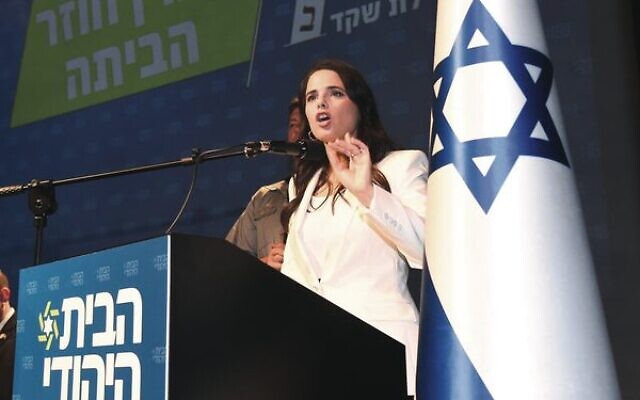Another week has gone by in the seemingly endless campaign (and indeed in a seemingly endless cycle of campaigns). But with the country celebrating Succot, and many people abroad, it is doubtful if anything has happened to impact the overall picture in the run-up to November 1.
Of the seven polls last week, four had the Benjamin Netanyahu-led opposition bloc on 60 seats, two had it at 59 and one had the bloc at 62. This brought the Netanyahu bloc’s average down from 60.4 to 60. This is still short of the decisive 61 seats he needs for a majority in the 120-member Knesset.
Ahead of us are chaotic days where the parties will finally use up the bulk of their budgets in the final stretch, and seek to eke out every vote as the fight over the pivotal 61st seat intensifies. With that in mind, here are four storylines which will be important in determining the final outcome.
The Haredi vote
First is the issue of the Haredi parties: Shas, representing the Sephardi ultra-Orthodox population and United Torah Judaism (UTJ) on the Ashkenazi side.
The parties have been extremely steady for the whole campaign, Shas on eight seats (and very occasionally, nine), and UTJ on seven – a total of 15 seats.
Looking back at recent elections, the two parties combined have generally done a little better than that. They have totalled 16 seats in each of the past four elections and have only dropped below 16 seats once in the past eight cycles.
What’s more, in recent years, the Haredi parties have consistently outperformed their polls: by almost four seats in April 2019, 1.6 seats in September 2019, and a more modest 0.3 seats and 0.9 seats in the past two rounds. So there is a good chance that they again get 16 seats.

Two questions arise from this. The first relates to the Itamar Ben-Gvir/Bezalel Smotrich issue. There has been talk that the Religious Zionism party is appealing to younger Haredi voters.
This demographic, it is argued, is more engaged with mainstream Israeli society than their parents – and therefore more open to voting for a non-Haredi party – but also more extreme on the traditional left-right spectrum.
If this is the case, and large numbers of young Haredim are going to vote for Religious Zionism, then it is possible that, this time, the Haredi parties won’t overshoot their polling.
However, the counter-argument is one of turnout.
According to this line of argument, pollsters have been unable to accurately gauge Haredi turnout, and therefore are consistently surprised when they vote in greater numbers.
If this is the case, and the Haredi parties gain an extra seat or two based purely on achieving differential turnout, then that could be pivotal.
After all, these are not voters they have won over from another party, which presumably would not change the bloc dynamics, but rather new voters, the impact of which would be to push all the other parties down slightly.
If this is the case, it could be the key to Netanyahu getting to 61 seats.

The Jewish Home and the threshold
The second storyline surrounds the fortunes of the Jewish Home party, led by Ayelet Shaked.
While the party has not passed the threshold in any poll yet, in the past week’s seven polls, it “won” an average of 2.2 per cent, one per cent short of the 3.25 per cent threshold.
The polls themselves show no particular sign of increase, but nonetheless, the party remains within touching distance of getting into the Knesset.
Moreover, a recent poll found that if Netanyahu called on his followers to vote for Jewish Home, the party would get four seats, pushing the Netanyahu bloc up to 62 seats.
On the flip side, the more people that vote for Jewish Home, the more votes that will be wasted if it falls just short of the threshold, which could well be equally decisive the other way. The Ayelet Shaked show could be the decisive story of this election.

Mind the gap
Analysis of this election has overwhelmingly been focused on blocs. But while the election will be decided on a bloc basis, the functioning of any future government will be heavily influenced by the parties that make up those blocs and, importantly, the varying strength of each party.
In short, the larger the dominant party in the bloc, the more power it will have in the coalition.
Inversely, the smaller they are, the more the weight shifts towards the smaller parties, which could bring instability, as Naftali Bennett very quickly found out during his shortlived premiership.
Within this context, it is worth noting the contrasting fortunes of the two biggest parties.

Likud began the campaign on around 35 seats and Yesh Atid on just over 20 – a gap of 15 seats. This gap has shrunk week by week. In total, Likud has lost around three seats in the past 16 weeks, while Yesh Atid has gained four, so today the gap has almost halved to 7.7 seats.
This says something about the strategies of both leading parties, and to a certain extent, vindicates both.
Netanyahu has been laser-focused on avoiding any wastage of votes on the right, working to unite various right-wing parties, and was happy to pay the price of that in the form of leakage of seats from Likud to Religious Zionism (although probably not to the extent currently unfolding).
In contrast, interim Prime Minister Yair Lapid wanted to establish Yesh Atid as the dominant party in the antiBibi camp.
Therefore, unlike in the last campaign, he has been actively “drinking from the left,” willing to risk the smaller parties in his bloc not crossing the threshold to maximise his own party’s slice of the pie (even though he would no doubt argue that Meretz, Labor and the Arab parties will all make it into the Knesset, making it “a calculated risk”).
If the smaller parties do clear the threshold, then Lapid will benefit from a larger Yesh Atid than many expected. But if they do not, Lapid will be blamed for strategic “recklessness,” cannibalising parties in his own bloc and handing a government to Netanyahu.
‘Herding’ or modelling?
The final issue is one of polling methodology and the question of “herding” – polling companies influencing or manipulating their public polls so that they match those produced by other companies, or as US forecasting guru Nate Silver calls it, companies “putting their fingers on the scales”.
This is because the extent of the consistency of the current polls is rare, to say the least.
In the past two weeks, there have been 14 polls, 11 of which have given the Netanyahu bloc 59 or 60 seats (two of the other three come from outlier Direct Polls).
Even within the blocs, polls are consistently showing the parties getting exactly the same number of seats — for example, Ra’am and Hadash-Ta’al (previously the Joint List) have got four seats each in the past 19 polls from six different companies. Statistically, such consistency is highly unlikely.
The Ayelet Shaked show could be the decisive story of this election.
These particular polls have margins of error of approximately four per cent, although this gets lower the further the reported percentage is from 50 per cent. So, around the five-seat mark, the margin of error can actually be around two per cent. This two per cent, though, would still give a party on five seats a range of three to seven in varying polls. And that is at a 95 per cent confidence level (meaning one of 20 polls would expect to be outside this range).
This level of week-in-week-out consistency is incredibly unusual. This level of polling consistency would be the equivalent of US President Joe Biden having polled at between 50 per cent and 51 per cent in virtually every poll in the space of three months.
Faced with this, too often the wrong questions are being asked by the media. Indeed, when Panels Politics conducted two polls on the same day (for different media outlets) and the results came back 59 and 60 seats for the Netanyahu bloc, respected political pundits questioned with outrage how that could be and what it said about the accuracy of the polls.

In reality, they should be asking why the polls are so similar, and not why there are differences.
This isn’t to say that polling companies are cheating. In fact, polls in Israel in recent years have proven extremely accurate, especially at the bloc level.
What the pollsters would argue is that through so many elections in recent years, their models and weighting methodologies have improved significantly, so they are able to weigh the data in a way that gives consistent (and accurate) results. However, this means that in all likelihood the results we are seeing may often be quite different from the raw data being collected.
The impressive record of accuracy for Israeli pollsters and their forecasting in recent years means they should certainly be given the benefit of the doubt.
At the same time, given this consistency, were the Netanyahu bloc to finish outside the 59-61 seat range, it would not look good.
All this, of course, comes with one big proviso. There are less than two weeks left until the election with a lot of campaigning to do. A lot can change.
When we asked a friend working in one of the campaigns how he felt things were going, his answer spoke volumes. “What do you mean?” he asked. “Everyone is on holiday. The campaign hasn’t started yet.”
A rollercoaster awaits on November 1.
Times of Israel
Simon Davies and Joshua Hantman are partners at Number 10 Strategies, an international strategic, research and communications consultancy, who have polled and run campaigns for presidents, prime ministers, political parties and major corporations in four continents. Disclosure: The authors have recently conducted polling on behalf of Meretz.


comments